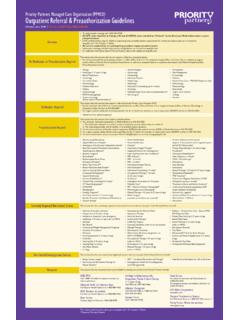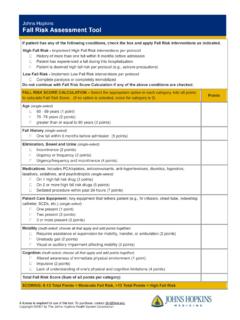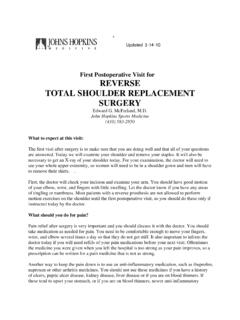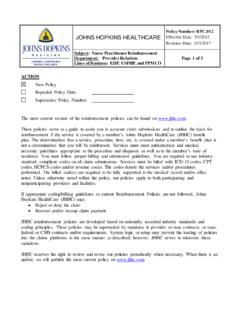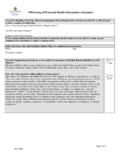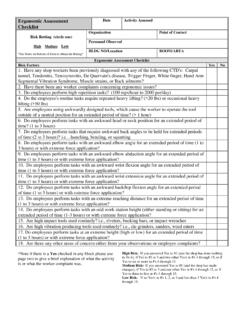Transcription of Gallstone Disease: Introduction - Hopkins Medicine
1 Figure 1. Location of the biliary tree in the Disease: Introduction Calculous disease of the biliary tract is the general term applied to diseases of the gallbladder and biliary tree that are adirect result of gallstones. Gallstone disease is the most common disorder affecting the biliary system. The trueprevalence rate is difficult to determine because calculous disease may often be is great variability regarding the worldwide prevalence of Gallstone disease. High rates of incidence occur in theUnited States, Chile, Sweden, Germany, and Austria. The prevalence among the Masai peoples of East Africa is 0%whereas it approaches 70% in Pima Indian women. Asian populations appear to have the lowest incidence of gallstonedisease. In the United States, approximately 10 15% of the adult population has gallstones, with approximately onemillion cases presenting each year.
2 Gallstones are the most common gastrointestinal disorder requiring annual cost of gallstones in the United States is estimated at 5 billion dollars. What is Gallstone (Calculous) Disease of the Biliary Tract?Gallstones, or choleliths, are solid masses formed from bile precipitates. These stones may occur in the gallbladder or the biliary tract (ducts leading from the liver tothe small intestine). There are two types of gallstones: cholesterol and pigment stones. Both types have their own unique epidemiology and risk factors. Cholesterolstones are yellow-green and are primarily made of hardened cholesterol. Cholesterol stones, predominantly found in women and obese people, are associated withbile supersaturated with cholesterol. They account for 80% of gallstones and are more commonly involved in obstruction and inflammatory.
3 Pigment stones may beblack or brown stones. Black pigment stones are made of pure calcium bilirubinate or complexes of calcium, copper, and mucin glycoproteins. These gallstonestypically form in conditions of stasis ( , parenteral nutrition) or excess unconjugated bilirubin ( , hemolysis or cirrhosis). Black pigment stones are more likely toremain in the gallbladder. Brown pigment stones are composed of calcium salts of unconjugated bilirubin with small amounts of cholesterol and protein. These stonesare often located in bile ducts causing obstruction and are usually found in conditions where there is infected bile. Brown pigment stones are prevalent in Asiancountries and are rarely seen in patients in the United States (Figure 2). Figure 2. Illustrations of cholesterol and pigment form when the bile, that is stored in the gallbladder, hardens into pieces of solid material.
4 This process requires three conditions. The first is that the bilemust supersaturate with cholesterol. This may occur when there is excess cholesterol with normal quantities of bile salts or normal levels of cholesterol withdecreased quantities of bile salts. The second condition is accelerated cholesterol crystal nucleation or the rapid transition from liquid to crystal. This occurs whenthere are excess nucleation factors or absence of nucleation inhibitors. The third condition for Gallstone formation is gallbladder hypomotility, a condition in whichcrystals to remain in the gallbladder long enough to form stones (Figure 3). Figure 3. Composition of bile with relationships that result in the formation of disease may not be symptomatic until there are complications.
5 Often these complications are caused by inflammation, infection, or ductal of calculous disease include: acute cholecystitis, choledocholithiasis, cholangitis, pancreatitis, emphysematous cholecystitis, cholecystenteric fistulae,Mirizzi s syndrome, and porcelain gallbladder. Symptoms and Clinical FeaturesMost people with gallstones do not have symptoms, however those who do have symptoms are much more likely to develop to 80% of symptomatic patients complain of biliary colic. Biliary colic is a visceral pain, thought to be caused by functional spasm, resulting from transientobstruction of the cystic duct by a stone. The pain is characterized as episodic and severe epigastric pain; less commonly, it is located in the right upper quadrant, leftupper quadrant, precordium, or lower abdomen.
6 The pain generally has a sudden onset, rising in intensity, and lasting from 15 minutes to several hours. Pain may beaccompanied by radiation to the interscapular region or the right shoulder often with vomiting and diaphoresis. Biliary colic may also present with symptoms ofnonspecific dyspepsia such as intolerance of fatty foods, pyrosis, flatulence, aerophagia sweating, yellowish color of skin or sclera of the eye, and clay-colored stoolsare symptoms that suggest complications such as cholangitis and choledocholithiasis and warrant immediate medical attention. The interval between attacks isunpredictable and may range from days to months or years. Copyright 2001-2013 | All Rights North Wolfe Street, Baltimore, Maryland 21287 Gallstone Disease: Anatomy The gallbladder is located under the surface of the liver, bound by vessels, connective tissue, and lymphatics.
7 It has four regions: the fundus, body, infundibulum, andthe neck. The gallbladder terminates in the cystic duct and then enters the extrahepatic biliary tree. The fundus is the round, blind edge of the organ. It is composed offibrotic tissue and projects just beyond the right lobe of the liver. The fundus leads to the body of the gallbladder, the largest part. The superior surface of the body isattached to the visceral surface of the liver, unless a mesentery is present. This close relationship allows for the direct spread of inflammation, infection, or neoplasiainto the liver parenchyma. The infundibulum is the tapering area of the gallbladder between the body and neck. This portion and the free surface of the body of thegallbladder lies close to the first and second portions of the duodenum, and in close proximity to the hepatic flexure and right third of the transverse colon.
8 Theinfundibulum is attached to the right transverse colon surface of the second part of the duodenum by the cholecystoduodenal ligament. The neck of the gallbladder is5 7 mm in diameter and often forms an S-shaped curve. It is superior and to the left, narrowing into a constriction at the junction with the cystic duct (Figure 4). Figure 4. Normal anatomy of the biliary systemThe right and left hepatic ducts unite in an extrahepatic position in most cases. The length of the hepatic lobar duct varies from cm. Usually, a shortextrahepatic right lobar duct joins a longer left duct at the base of the right branch of the portal vein at differing angles. The common hepatic duct is formed by themerger of right and left hepatic ducts. In a minority of cases, a right segmental duct joining a left hepatic duct forms a third duct.
9 There may be numerous variations inthe left ductal system (Figure 5). Figure 5. Variations in the anatomy of the cystic ductTwenty percent of the population has accessory hepatic ducts. In these individuals, the aberrant duct joins the common hepatic duct at various locations along itscourse. In rare instances this aberrant duct may join the cystic duct or a duct in the opposite lobe. Usually, however, these aberrant ducts are on the right side (Figure6). Figure 6. Variations in the anatomy of the gallbladder and biliary tree. The hepatocyte-cholangiocyte level is the beginning of the biliary drainage system and where portions of the hepatocyte membrane form the canaliculi (smallchannels). Bile drains from this level into intrahepatic ducts. The canaliculi and proximal ductal system converge in the canal of Hering.
10 Smaller ducts combine to formthe segmental bile duct. segmental ducts within the liver form the right and left hepatic ducts. Union of ducts from hepatic segments II, III, and IV form the left lobarduct. The right hepatic duct drains segments V, VI, VII, and the intrahepatic ducts are cholangiocytes (epithelial cells). The cholangiocytes line complex networks of interconnecting tubes involved in secretory andabsorptive processes. Cholangiocytes may be cuboidal in smaller ductal structures. They are columnar in larger structures and contain microvilli increasing surfacearea. These cells are believed to play a role in transport functions (protein from lymph or plasma into the bile). It is also probable that they are involved in the transportand metabolism of bile acids.


